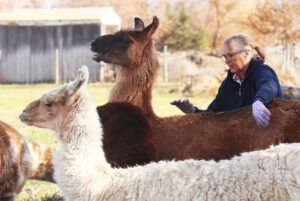
by John Dowd
For most of her life, Char Hakes has been working with llamas. She opened and operates Safe Haven Llama and Alpaca Sanctuary, and expressed that “it’s just what I do, it’s just who I am.” She loves the animals, and wants to continue helping them for years to come. However, she explained that she is starting to feel her age.
Fortunately, several weeks ago, Hakes received a new batch of nine “feral llamas” that re-energized her resolve to help these unorthodox animals. The group consists of animals of a variety of ages, with some as old as 20 years. The group was taken in for a short time by Prairie Song Sanctuary, who then heard about Safe Haven. The sanctuary contacted Hakes, and she excitedly expressed that she was able to take in the group of llamas.
Many of the llamas and alpacas she rescues have been seriously neglected. This group in particular was living wild on a piece of land near Livingston. According to Hakes, they have especially neglected coats. She spoke on how matted the fibers can get on neglected llamas, and how she will need to wait until they are more tame to be able to get close enough to trim them without irritating them. Some llamas she has received in the past have had coats so full and neglected that she has found fish hooks, sticks and even dead mice in their fur.
So far, Char said, it’s “baby steps” with these close knit animals. For the first few months, Hakes’ main goal has been just to try to get them used to people coming into the enclosure. Hakes hopes to start training them soon and to put more work into eliminating the fear that they have of humans. One of these steps will be to get them comfortable with getting into a pen alone, as they do not like to be separated. This is essential for the care of the animals, allowing caretakers to do things like trimming and foot maintenance.
Hakes likes to use clicker training and believes it is important to find the “right things for the right llamas.” According to Hakes, each one is unique and learns in a different way, responding to different stimuli.
Safe Haven Llama and Alpaca Sanctuary is home to over 30 animals, and Hakes started the nonprofit in 2005. After 18 years, “Every day is different,” said Hakes. That is one of her favorite parts about working with llamas. She believes with each new day there is something new to learn about them, and she has become very attached to the animals over the years. With many of the llamas living for nearly 30 years, several of the animals the sanctuary has had have come and died there. For Hakes, each loss is hard. “I really needed an uplift, so I’m glad that these guys came,” said Hakes about the new batch. This is especially true because she has had several animals recently age out and pass away, which has tried her resolve to continue.
Hakes said that her love for llamas started when she was around 30. One day she saw some in the valley and became very interested in having some. “I’m a farm girl from around here. We didn’t have llamas!” said Hakes. She started learning about the animals and started working with them in 1989. “When I’m out here, I feel at my best,” said Hakes.
She believes there are a lot of strong reasons to have llamas. According to Hakes, they make great pack animals for carrying gear into the mountains with their mild temperament, high intelligence, as well as their good height and bone structure. Llamas also love getting up into the hills and on trails, as that is a lot like their native environment in South America. Additionally, they make good sheep guardians, produce fiber which can be used for clothing and garments and Hakes believes they also make great assisted therapy animals. “They’re comforting and easy going,” she said.
In fact, that is one of the things the sanctuary prides itself in. For years, the sanctuary has used llamas for therapy. There are several groups throughout the valley that come out to spend time with their llamas. “They just give you peace,” and “we love visitors!” said Hakes. The sanctuary allows people to visit and spend time with the llamas and alpacas year round, and she is always looking for help caring for the animals.
The sanctuary also adopts out many animals. There is an application form and interested adopters need to go through a background check. The heavy screening is done to protect the animals after they leave the sanctuary, and to hopefully put them into better homes. Above all else, Hakes wants to prevent their animals from returning to neglectful homes because “they already came from a place like that,” said Hakes.
Safe Haven sells compost, which Hakes says is some of the best. Llama dung is healthy for the soil, leaving less acidity and has a high nutrient yield, according to Hakes. They even donate some to various valley garden clubs. The sanctuary also sells the “beans,” which is what she calls the llama poop, for people to use mixed with water for their plants. “They are the best beans ever!” said Hakes.
For more information, interested parties can go to the sanctuary website, www.safehavenllamas.org, or visit their Facebook page.